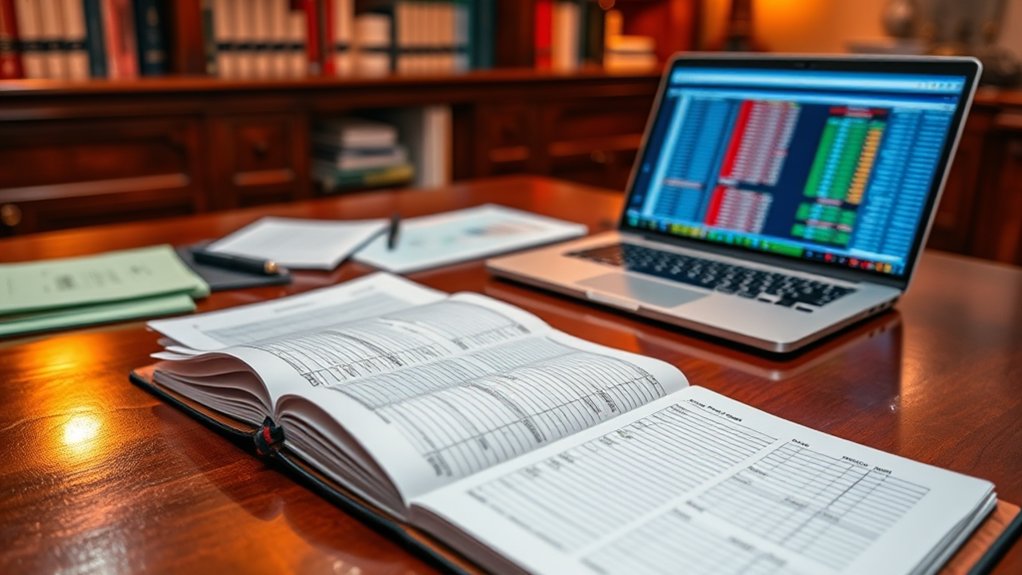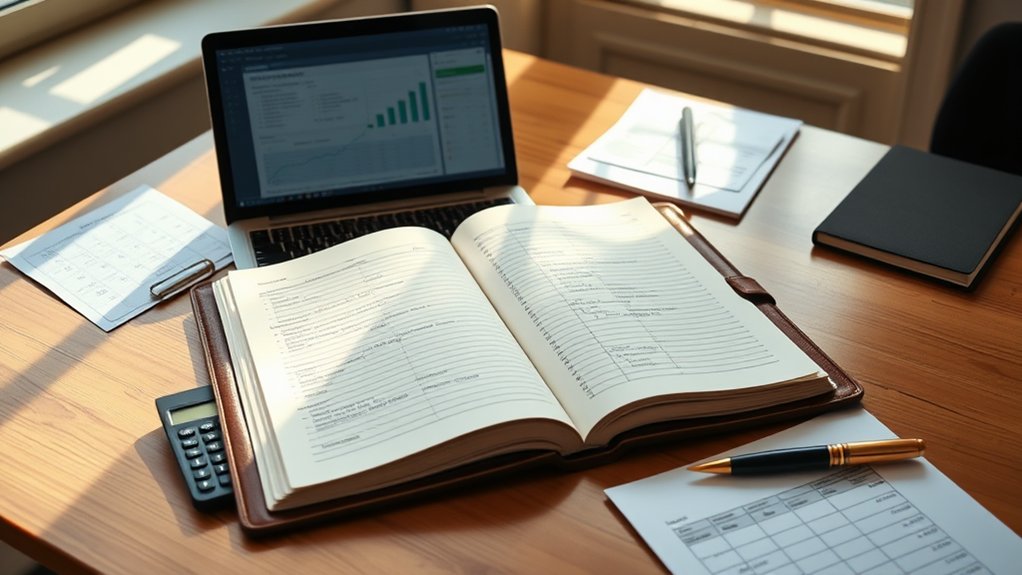A general ledger is your business’s master accounting document that records and tracks every financial transaction. It consists of five core components: assets (what you own), liabilities (what you owe), equity (your net worth), revenues (income), and expenses (costs). Through double-entry accounting, each transaction affects at least two accounts, with debits equaling credits to maintain balance. Managing your general ledger effectively requires proper setup, consistent reconciliation, and strategic organization – essential principles I’ll explain in detail below.
The Core Components of a General Ledger

A general ledger consists of five fundamental components that form the backbone of an organization’s financial records: assets, liabilities, equity, revenues, and expenses.
I’ll break these down for you. Assets represent what you own and control, from cash to equipment. Liabilities encompass what you owe to others, including loans and accounts payable. Equity reflects your organization’s net worth – the residual interest after subtracting liabilities from assets. Revenue accounts track the income you generate through operations, while expense accounts monitor the costs you incur to run your business. Together, these components create a complete financial picture of your organization’s position and performance.
Setting Up Your Business’s General Ledger
To set up your general ledger effectively, I’ll guide you through establishing a customized chart of accounts that organizes your financial transactions into distinct categories like assets, liabilities, equity, revenue, and expenses. You’ll need to decide between manual and digital systems, though I strongly recommend accounting software for its automation capabilities, error reduction, and real-time reporting features. Your account categories must align with your business’s specific needs and industry standards while maintaining compliance with generally accepted accounting principles (GAAP).
Chart of Accounts Setup
Setting up your business’s general ledger begins with creating a chart of accounts, which serves as the foundation for your organization’s financial record-keeping system. I’ll help you structure your accounts into five main categories: assets, liabilities, equity, revenues, and expenses. Each account receives a unique identifier, typically a numeric code, that facilitates organized tracking and reporting.
I recommend implementing a scalable numbering system: use 1000s for assets, 2000s for liabilities, 3000s for equity, 4000s for revenue, and 5000s for expenses. This systematic approach enables efficient financial analysis, tax compliance, and strategic decision-making while allowing for future business growth.
Software Vs Manual Systems
When choosing between software and manual systems for your general ledger, it’s vital to evaluate your business’s specific needs and resources. Modern accounting software offers automated features that considerably reduce errors and save time, while manual systems provide greater control and understanding of each transaction.
- Automated software reduces data entry time by 80% compared to manual systems
- Cloud-based solutions enable real-time access and collaboration
- Manual systems offer better understanding of accounting fundamentals
- Software includes built-in audit trails and security features
- Hardware and training costs impact total system expenses
I’ll help you select the ideal system based on your company’s transaction volume, budget, and reporting requirements.
Define Account Categories
A properly structured general ledger begins with defining clear account categories that align with your business’s financial activities. I’ll organize your chart of accounts into five primary categories: assets, liabilities, equity, revenue, and expenses. Each category requires specific numbering conventions – I typically assign assets (1000-1999), liabilities (2000-2999), equity (3000-3999), revenue (4000-4999), and expenses (5000-5999). This systematic approach enables you to track every transaction precisely and maintain control over your financial data. Within each category, I’ll create subcategories that reflect your specific business operations and reporting needs.
Double-Entry Accounting and General Ledger Basics

I’ll explain how double-entry accounting maintains balance through the fundamental rule that debits must equal credits in every transaction. When you record multiple account entries in your general ledger, each transaction affects at least two accounts – one with a debit and one with a credit – creating a clear audit trail of your business activities. These balanced entries then flow into your financial statements, where the general ledger serves as the primary source for creating your income statement, balance sheet, and other essential reports.
Debits Equal Credits Rule
Double-entry accounting relies on a fundamental rule: debits must always equal credits. I’ll help you understand this critical principle that forms the backbone of all accounting systems and maintains financial equilibrium in your books.
- Every transaction affects at least two accounts
- Left side entries (debits) must equal right side entries (credits)
- Asset and expense increases are debits
- Liability, equity, and revenue increases are credits
- Total debits must match total credits in your trial balance
When I record a transaction, this rule guarantees perfect balance, making it impossible to misstate your financial position. It’s a powerful control mechanism that validates every entry and safeguards your financial integrity.
Recording Multiple Account Entries
Building on the debits and credits rule, most business transactions require entries in multiple accounts to maintain proper balance. When I record a business transaction, I’ll typically affect at least two accounts. For example, if I purchase equipment with cash, I debit the equipment account and credit the cash account.
I must guarantee each transaction’s debits equal its credits across all affected accounts. If I buy $10,000 in inventory on credit, I’ll debit inventory for $10,000 and credit accounts payable for $10,000. This maintains the fundamental accounting equation and creates a clear audit trail.
Financial Statement Creation Process
Every financial statement creation process begins with accurate double-entry accounting in the general ledger. I’ll show you how to transform your general ledger data into powerful financial statements that reveal your business’s true financial position.
- Extract trial balance data from your general ledger accounts
- Analyze and adjust entries for accruals, deferrals, and reconciliations
- Group accounts by financial statement category (assets, liabilities, equity, etc.)
- Apply GAAP or IFRS standards to guarantee compliance
- Generate balance sheet, income statement, and cash flow statement
Mastering this process gives you complete control over your financial reporting and strategic decision-making capabilities.
Common Types of General Ledger Accounts
General ledger accounts fall into five primary categories that form the foundation of financial record-keeping: assets, liabilities, equity, revenue, and expenses.
I’ll define each category for you. Assets represent what you own and control, including cash, inventory, and equipment. Liabilities encompass what you owe, such as loans and accounts payable. Equity reflects your ownership stake, including investments and retained earnings. Revenue accounts track your income from sales and services. Expenses capture the costs of doing business, from payroll to utilities.
Together, these accounts enable you to maintain precise control over your financial position and performance.
Best Practices for General Ledger Management

Managing a general ledger effectively requires structured protocols and consistent oversight to maintain the accuracy of those five account categories. I’ll show you the critical best practices that guarantee your ledger remains a powerful financial control tool.
- Implement daily reconciliation processes to catch discrepancies immediately
- Establish strict access controls and approval hierarchies for entries
- Document all transactions with detailed descriptions and supporting evidence
- Maintain a standardized chart of accounts with clear naming conventions
- Schedule regular internal audits to verify accuracy and compliance
These protocols transform your general ledger from a basic accounting record into a strategic asset that drives informed decision-making and maintains financial control.
Digital Tools and Software for General Ledger Tracking
Modern businesses have revolutionized general ledger management through sophisticated digital tools and automation software. I recommend industry-leading platforms like QuickBooks Enterprise, Oracle NetSuite, and SAP ERP for robust ledger tracking. These systems offer real-time synchronization, automated journal entries, and multi-currency support.
You’ll gain strategic advantages through advanced features like audit trails, customizable reporting dashboards, and AI-powered analytics. Cloud-based solutions enable secure remote access and seamless integration with other financial modules. To maximize ROI, I suggest implementing role-based access controls and automated reconciliation tools while leveraging built-in compliance frameworks to maintain regulatory standards.









